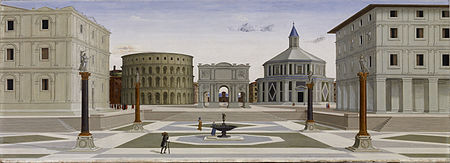The Ideal City (painting)
| The Ideal City | |
|---|---|
 |
|
| Artist | Attributed to Fra Carnevale |
| Year | between circa 1480 and circa 1484 |
| Type | oil and tempera on panel |
| Dimensions | 77.4 cm × 220. cm (30.5 in × 86.6 in) |
| Location | The Walters Art Museum, Baltimore |
The Ideal City (Italian: 'Città ideale') is the title given to three strikingly similar Italian Renaissance paintings with unresolved attribution. Being kept at three different places they are most commonly referred to by their location: The Ideal city of Urbino, Baltimore, and Berlin. Hubert Damisch who has written at length about the paintings refers to them as the "Urbino perspectives" or "panels". The three paintings are dated to the late 15th c. and most probably they have different authors but various attribution have been advanced for each without any consensus. There is also a discussion about the purpose of the paintings as they are all in an unusual elongated format (approx. 2.0 x 0.7m). In 2012 The Baltimore and Urbino panels were shown at a joint exhibition, with the Berlin painting being presented in a copy as the original is too fragile to be shipped abroad.
The Ideal City stored in Urbino was formerly attributed to Piero della Francesca, then to Luciano Laurana, Francesco di Giorgio Martini or Melozzo da Forlì.
The Ideal City stored in Baltimore is a 15th-century painting usually attributed to the architect and artist Fra Carnavale. The painting was most likely executed for the Ducal Palace, Urbino of Federico da Montefeltro, duke of Urbino. There is no indisputable evidence for this, but Carnevale was one of three architects used for renovations to the palace. Furthermore, in an inventory of the palace completed in 1599 there is mention of a "long rectangular painting depicting an antique but beautiful perspective from the hand of Carnavale". The panels might have been spalliere, forming part of a decorative scheme set into the wainscoting or furnishings, a style common in Italy in the late 15th century.
However, the painting is attributed by others to Francesco di Giorgio Martini, partly due to the latter's greater significance at the Urbino court and because the painting refers to architectural themes he refers to, derived from Leon Battista Alberti's slightly earlier published treatise, in his own architectural treatise.
...
Wikipedia
